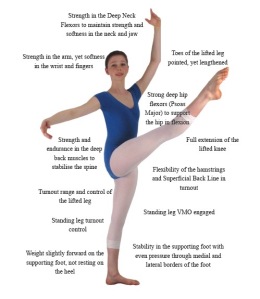Another great video from Lisa Howell! After purchasing new shoes, here’s a good way to begin properly breaking them in.https://www.youtube.com/watch?v=XYJoVbnKlyA
Adrenal Burn-Out
At one time or another, we’ve all suffered exhaustion. End of school term, recitals, finals, moving, caring for loved ones – the list is endless but the solutions might confuse us.  Already fatigued, we’re in no position to make sound decisions based on what’s right for each individual. That’s where a patient advocate comes in – a trusted supporter who has our best interests in mind and is thinking far more clearly than we are at that moment.
Already fatigued, we’re in no position to make sound decisions based on what’s right for each individual. That’s where a patient advocate comes in – a trusted supporter who has our best interests in mind and is thinking far more clearly than we are at that moment.
That said, there are general areas we need to explore to heal as quickly and completely as possible. Long term exhaustion can permanently damage our mental and physical health and that is the primary intent of this post. TAKE CARE OF YOURSELF IMMEDIATELY OR YOU MAY PAY FOR YOUR NEGLECT THE REST OF YOUR LIFE!! With help from your advocate;
- Review your diet
- Investigate what created the stress
- Evaluate your fluid intake
- Assess your sleep patterns
- Examine how you care for yourself
- Question your physical routine
- Lovingly make a plan for renewed health
I’ve had the good fortune of excellent health during my life but I’ve taken responsible steps to stay informed and not depend on health pros to do my work for me. Not because I’m clever however. Mostly this happened because I’ve been underinsured most of my life and couldn’t depend on the health care system because of the cost. But every ache and pain has some explanation and if you make a habit of listening, the human body generously delivers the answer.
Best Turn-Out Exercise
Since many of you are asking, here is the best turnout exercise I can find for you to increase range and build functional turn out.Thanks to Lisa Howell and the ballet blog! https://www.youtube.com/watch?v=vFdl7qRbEjU I’m including a beautiful example of what it looks like when everything is working as it should be.
The Proper Tendu
And who else could show us as well as my favorite dance physiotherapist, Lisa Howell?? Scroll down the page for the video – http://www.theballetblog.com/portfolio/how-to-perform-the-perfect-tendu/?mc_cid=56526c1303&mc_eid=debdeb6e2b

Plantar Fasciosis (Fasciitis)
The latest findings:spread your toes !! https://www.youtube.com/watch?v=tNPfbB2sX5Q&sns=em
Flexibility and the Dancer
Exploring how the human body works is of particular interest to dancers and no area is more exciting and emotionally charged than flexibility. It’s an important issue for dancers because it not only affects us functionally, but aesthetically as well.
In the dance biz, functional mobility is part of a triad along with balance and strength that develop incrementally. There are many factors that affect flexibility including hormones, growth rate, hydration, genetics/talent, diet, lifestyle, stress, and tension. This is a relief for many dancers to learn – it isn’t that they’re lazy, not as good as others, or don’t practice enough. The human body is massively intelligent. A growing child needs stability more than mobility in most cases. As they become more proficient in their movement skills – stronger and more coordinated, they are able to relax more and mobility increases.
Fascia (which envelops, separates, and binds together muscles, organs, and other soft structures of the body) has several properties including elasticity, plasticity, and viscosity. Fascia also develops tension that limits mobility. Because the entire fascial body is interconnected, a single restriction in one area of the body (surgery adhesion, injury, poor posture, inactivity, tension, etc) will emanate into other parts of the body causing fascia to ‘felt’, reducing movability – think early morning stiffness after the body has been at rest all night. For a dancer, this inflexibility can be confusing and frustrating.
In technique classes at PDC, we teach flexibility practices to ensure students know proper approaches to safe stretching. We teach dancers when to safely stretch, why warm-up prior to stretching is critical, and multiple at-home skills to improve agility. In almost every ballet class, dancers write in their journals about strength, flexibility, and balance goals and ways to achieve them. They’re instructed that all 3 develop simultaneously and work in one area improves all three.
So for those looking to improve and be a more proficient dancer, there really aren’t any shortcuts. Training and class time is the easy answer to developing an organized, strong, and supple body, resistant to injury. And with the proper information and the motivation, we are confident that success will follow for each of our dancers.
Just In Time For Halloween
Make Your Own Healing Boo-Boo Stick for First Aid by Gaye Levy
Ingredients
- 20 drops Lavender essential oil
- 20 drops Melaleuca (Tea Tree) essential oil
- 10 drops Oregano essential oil
- Witch Hazel
Directions
- Add essential oils to a small, 10ML glass roller ball bottle. Top with witch hazel.
- Before using, give it a quick shake then apply liberally to cuts, scrapes, bug bites, blemishes and zits (admit it, we still get them) and just about anywhere else you would normally apply antiseptic ointment.
Options
- Use a small spray bottle instead of a roller ball.
- Instead of witch hazel, use fractionated coconut oil
- If you prefer an ointment, mix the ingredients into 2 teaspoons of my Simple Salve. (See DIY Salve: An All Purpose, All Natural Ointment and learn to make it your self!)
How Does It Work?
The essential oils used in this miracle first aid stick are well known for their healing qualities. With the addition of soothing and calming witch hazel, you have a combination that will seal the fate of those everyday cuts, scrapes, and bites that I so fondly call “boo boos”.
Lavender: Lavender has historically been used to clean and help heal wounds and burns, and to address skin issues of all types. It is antibacterial, anti-inflammatory, antiseptic, and antiviral.
Resource: The Miracle of Lavender Oil: 25 Amazing Uses for Survival
Melaleuca (Tea Tree): Melaleuca acts as a stimulant and helps the body fight off bacteria, infections, viruses, and illness. It is antibacterial, anti-fungal, antiseptic, and antiviral.
Resource: The Miracle of Tea Tree Oil: 80 Amazing Uses for Survival
Oregano: Historically, oregano was used by ancient Greek physicians to treat wounds and bites. Many members of the modern medical community consider oregano to be natures antibiotic. It is antiviral, antibacterial, antifungal, anti-allergenic, and anti–inflammatory.
Resource: 25 Ways to Use Oregano Essential Oil for Health and Wellness
Witch Hazel: Witch Hazel is antibacterial, anti-inflammatory, and moisturizing. Historically it has been used for acne, sunburn, stings and bites, razor burn and nicks, blisters, and other skin woes. It is perfect for cleaning wounds and reducing inflammation and swelling.
What Can I Use the Boo-Boo Stick For?
I could list all of the uses for this miracle first aid stick but let me just say this:
- Use it anytime you would normally reach for a tube of Neosporin.
- Use it for treating and preventing infections from minor cuts, scrapes, bites and burns.
- Use it to calm itching, reduce inflammation and swelling, and to promote healing without reliance on chemical laden petroleum products.
- Most of all, use it whenever you feel that an OTC first aid cream or ointment is warranted.
The Final Word
As with all of my lotions, ointments, salves and other concoctions, this is the formula that works for me. I find that it is quick and effective plus it uses some of the more common and less expensive essential oils. The one caveat I have is that you want to be mindful that oregano is a “hot oil” and even though it is well-diluted, you should keep it away from the eyes.
Something else to keep in mind is that if you happen to be in the kitchen and don’t have your boo-boo stick handy, reach for some honey. It, too, has healing qualities that are proven to reduce the incidence of inflammation and infection.
And finally, it goes without saying that using essential oils for minor skin irritations is just fine. For serious wounds, however, please follow the advice of your healthcare practitioner. Let common sense prevail.
Enjoy your next adventure through common sense and thoughtful preparation!
Gaye
Looking for a Dance College???
try this link – visit/http://dancepathways.org/planning-for-your-college-visit/
Youth Fitness On Steady Decline
Frustrated American educators have watched while those in power have ignored recommendations and research that has suggested this for over 25 years although families that can afford to give their child the greatest gift they have to give, a dance education, can be assured of good fitness throughout their lifetimes because of this early investment. http://yogauonline.com/yogatherapy/yoga-for-kids/yoga-for-kids-practice/2016050415-youth-fitness-steady-decline
